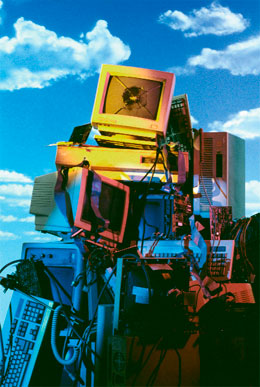|
TECHNOLOGY
Thinking green, going green, saving green
"E-cycling" obsolete technology helps the environment, needy organizations and the bottom line
By John Chivvis
You work with them day in and day out, but according to the statistics, the electronics—computers, monitors, printers, peripherals, and cell phones—that occupy your office landscape could hurt the environment, your business and your profits.
The problem comes when it’s time to dispose of these devices. If disposed of improperly, chemicals and toxic materials can enter the air and water. However, if these electronic products are recycled the right way—or “e-cycled” as it’s being called—businesses can benefit environmentally, socially and even financially.
What’s the big deal?
“Nothing drives me crazier than seeing a computer sitting out by the side of a road,” claims Frank Westfall, vice president for ESIS Global Risk Control Services’ Health, Safety and Environment (HSE) unit. As part of a team that specializes in environmental risk assessment for ESIS, Inc., and its affiliates within the ACE Group of Companies, Westfall sees that dumped CPU as just that—a risk.
“Although modern landfills are designed to contain the chemicals and other materials deposited in them, dumping anything into a landfill presents a risk that someday materials may spread beyond the landfill site itself,” says Westfall. “Electronic devices may contain amounts of lead, mercury, selenium, palladium and other organic compounds.”
Lead, for example, is used in soldered circuits for computers, and anywhere from two to four pounds of lead can be found in the glass of CRT monitors. Mercury is used in the lighting of flat panel monitors and laptops. Other elements like cadmium can be found in laptop and rechargeable batteries.
But it’s not just the chemicals that should cause concern; it’s also the amount of technology being dumped. In 2007, the U.S. produced more than 2.25 million tons of e-waste—TVs, computer products, computer peripherals (mice, keyboards, and printers), and cell phones—according to a recent electronics waste management report published by the Environmental Protection Agency (EPA).
Eighty-two percent of these devices—a whopping 1.84 million tons—were disposed of, primarily in landfills. “Eighteen percent recycled is disappointing,” admits Westfall, pointing to a lack of federal e-cycling regulations.
However, Westfall and the EPA believe that number will grow over the next few years due to growing state legislation and local e-cycling programs. “Seventeen states as well as New York City have or will have regulations in place for more efficient disposal of electronics like cell phones, fax machines, monitors, and printers,” says Westfall. “It’s hard to get landfills approved these days, so state and local governments are finding better ways to manage electronic waste.”
Why reduce, reuse, and e-cycle?
On a local and personal level, individual consumers and businesses are faced with managing e-waste. For businesses such as insurance agencies, workstation/printer upgrade programs, telecommuting hardware/laptop purchases and cellular phone plans increase the number of electronics and computer products an agency has to contend with.
Beyond the dumping aspect, there’s also the storage of unused or “end-of-life” products. The EPA estimates thatmore than 235 million pieces were stockpiled in the United States in 2007. For cell phones, their average life span is about 20 months and Gartner predicts that more than 1 billion cell phones will be sold in 2009.
The Travelers Companies can attest to this. As part of their overall “green” strategy, they launched a campaign they called “Green Days” to collect old or unused company-owned computer equipment. “We support a ‘zero-landfill’ policy when it comes to computers,” states Andy Bessette, Travelers’ chief administrative officer, “because knowing that there’s an estimated 60 million computers already in landfills is a little scary.”
So as part of the Green Days campaign, Travelers posted campaign posters and sent e-mails out to employees at their corporate headquarters and field offices. “Recycle Me” stickers were provided to employees, and all they had to do was to tag the old or unused equipment lying around their offices and workspaces.
Over the course of the three-month campaign, Travelers ended up collecting more than 9,200 pieces of computer equipment. Bessette says that more than 500 pieces were redeployed—for instance, replacing an older printer with a newer printer that was turned in. “Besides the obvious environmental impact, the fiscal impact is that we don’t have to spend money on equipment if it can be reused,” says Bessette.
Bessette also says that the carrier was able to recycle more than 4,000 computers and 4,000 monitors. “While Travelers gives over $17 million each year to charities,” notes Bessette, “in this case, we were able to donate the equipment to a number of local community centers and schools for use.”
While the social impact is felt from the donation of the equipment, Bessette says that there’s a fiscal component to the reduction of the inventory via donation. “We’re not having to pay software licenses or maintenance fees on that equipment anymore, and we’re also able to remove 8,000 pieces from our inventory and property tax rolls,” says Bessette.
In fact, the success of the Green Days initiative led Travelers to add e-cycling resources to their intranet to continue the education of what to do with old or unused equipment.
What about me?
Based on Westfall’s and Bessette’s own respective expertise and experi-ences, e-cycling devices, products and peripherals prove to be a win-win-win situation.
For the environmental “win,” efficient reuse and recycling of end-of-life electronics conserves natural resources. According to the EPA, if the estimated 100 million cell phones ready for end-of-life management in 2006 had been recycled, enough energy would have been saved to power nearly 194,000 homes in the United States with electricity for an entire year. Proper e-cycling also avoids air and water pollution as well as greenhouse gas emissions caused by manufacturing new products.
Socially, as Travelers illustrated, donating equipment can really impact a community, school or nonprofit organization. There are also a number of collection programs for cell phones and computers that refurbish and repurpose them for use by charities or to complement fundraising activities. Before donating though, Bessette offers an important reminder: “Make sure the hard drives and memory are wiped or erased before donating because of the sensitive data and information that might be on them.”
Fiscally, e-cycling efforts can stretch IT investment and expenditures. Westfall says it’s important for a business to look at its electronic product lifecycles and plan out how devices can be redeployed for further use. Many businesses develop a roll-down plan for machines, monitors and printers in order to stretch the life of the item. The more an item can be reused, redeployed or recycled, the more money can be saved.
Ultimately it all comes down to a shift in mindset on how these devices are end-of-lifed. “In some cases, e-cycling may be as simple as making a phone call,” says Westfall. “Just don’t dump it first.”
Bessette agrees, adding that being environmentally responsible and being fiscally responsible doesn’t have to be mutually exclusive. Borrowing from the Green Days campaign slogan, Bessette says, “It’s good for the Earth…and it’s good for our bottom line.” *
E-CYCLING RESOURCES
To learn more about e-cycling initiatives and resources as well as local programs and opportunities, take a look at the following Web sites:
• E-cycling Central
www.eiae.org/
Besides a map-based application to offer local programs and recycling options, this site sponsored by the telecommunications industry also offers a great set of questions that anyone should ask potential recyclers.
• Environmental Protection Agency
www.epa.gov/epawaste/
Clicking on the “Electronics Recycling (eCycling)” link provides a list of resources that include e-cycling FAQs as well as an extensive list of manufacturer and retailer e-cycling programs.
• MyGreenElectronics
www.mygreenelectronics.org
Learn more about local recycling programs, buying green devices, and even calculate how much energy your devices, office, or business consumes.
• National Center for Electronics Recycling
www.electronicsrecycling.org
NCER offers information and tips on manufacturer recycling programs and insights on donating equipment. |
(Editor’s note: This is the first part of a three-part series on how the insurance industry is addressing the disposal of aged technology. Parts two and three will appear in the February 2009 issue and the April 2009 issue respectively.)
The author
John Chivvis is a Texas-based writer who specializes in topics of technology implementation. His work has appeared in a number of national and regional publications. |
|
| |
 |
| |
In 2007, the U.S. produced more than 2.25 million tons of e-waste—TVs, computer products, computer peripherals (mice, keyboards, and printers), and cell phones.
—Environmental Protection Agency
|
| |
 |
| |
“Although modern landfills are designed to contain the chemicals and other materials deposited in them, dumping anything into a landfill presents a risk that someday materials may spread beyond the landfill site itself.”
—Frank Westfall
Vice President
ESIS Global Risk Control Services’
Health, Safety and Environment Unit
|
| |
 |
| |
“Travelers supports a ‘zero-landfill’ policy when it comes to computers because knowing that there’s an estimated
60 million computers already in landfills
is a little scary.”
—Andy Bessette
Chief Administrative Officer
Travelers |
|